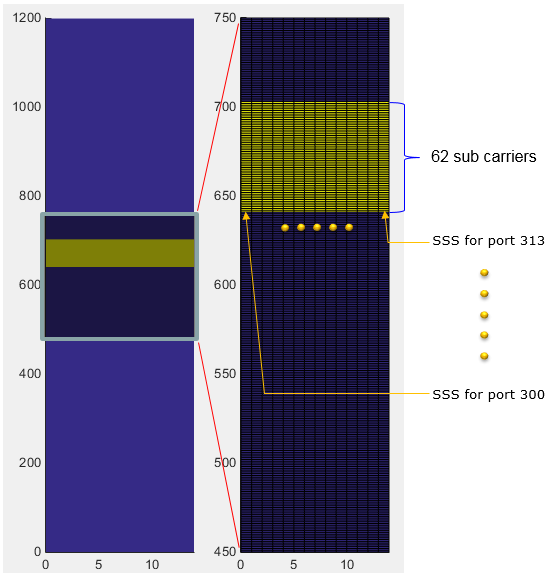|
5G/NR - Pre Trial - Physical Signal - PSS |
|||||||||||
|
NOTE : This note is about a tempary 5G specification that was implemented and tried before 5G specification is finalized. I keep this note for study purpose.
SSS (Secondary Synchronization Signal)
SSS is a specific physical layer signal that is used for radio frame synchronization. It has characterstics as listed below.
Baseband Signal Generation
The signal generation algorithm of Pretrial SSS is same as LTE SSS. It generate 512 different Gold sequences that are made up of 62 data points as shown below. This is same as LTE SSS signal generation. 512 different Gold Sequence is distictively generated by the two parameter NID(1) and NID(2). NID(1) can be 0 or 1 or 2. NID(2) can be any value from 0 through 167.
One example of SSS sequence is shown below.
Disclaimer : This code is just to push myself (probably readers) to look into the algorithm (formula) specified in the specification to the most detailed level. If you try to convert the specification into the programming code whatever language you choose, you will understand the equation / algorithm in much more detailed level than just reading the document. However, this code has not been verified with any real data.
RE Mapping(Resource Element Mapping) of SSS
The location of SSS within a radio frame is as highlighed in red box below. It is at the center of the frequency domain in subframe 0 and 25.
If you cut out only subframe 0 and maginify the resource elements above PSS, it looks as shown below. In case of LTE SSS, it occupies only one OFDM symbol but in 5G Pretrial it occupies the whole subframe (i.e, 14 OFDM Symbols). Why it use 14 OFDM symbols ? Actually, the data being carried by each OFDM symbol is same in every symbol. The difference is with antenna ports. As you see below, each of OFDM symbol for PSS is mapped to different antenna ports. These antenna ports will use different Beam Configuration. In short, the same SSS signal is being transmitted in every symbols in subframe 0 and 25 with different beam direction for each symbol. (If you are interested in the fundamental idea of this type of transmission, refer to Synchronization Signal in a frame structure).
Matlab Code : SSS
|
|||||||||||


